Maine, located at the northeastern tip of the United States, is known for its rugged coastline, mountainous landscapes, and the iconic Maine lobster.
It is also famously the home state of celebrated author Stephen King.
Despite its scenic beauty and cultural significance, Maine is the 41st most populated state in the country.
The state’s diverse terrain contributes to its sparse population distribution.
Current estimates for 2025 indicate a population of 1,402,110, reflecting gradual growth over the years.
However, Maine has one of the slowest population growth rates in the U.S., at just 0.03%, ranking 48th out of all 50 states.
Table of Contents
ToggleMaine shares its borders with New Hampshire to the southwest and the Canadian provinces of Quebec and New Brunswick to the northwest and northeast, respectively. Its strategic location and natural beauty make it a unique and significant part of the United States.
Key Takeaways
Population Density
Back to population density maps with one of Maine.#rayshader adventures, an #rstats tale pic.twitter.com/72f0Hx2EDy
— terence (@researchremora) December 5, 2021
Maine has a population density of just 43.1 people per square mile across its 35,380 square miles, making it the least densely populated state in New England, the American Northeast, and along the eastern seaboard. It also holds this distinction among states with an Atlantic coastline and those located east of the Mississippi River.
The Greater Portland metropolitan area is the most densely populated region in the state, accounting for 40% of Maine’s total population. In contrast, much of Maine consists of remote, uninhabited lands, particularly in its vast interior.
Cumberland County is the largest county in Maine by population, while Portland is the state’s most populous city, home to over 67,000 residents.
Age Structure
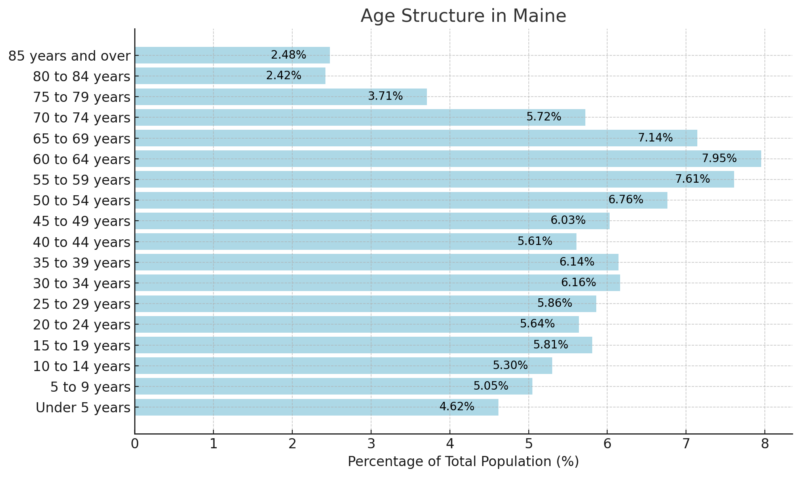
The median age in Maine is 44.8, according to the 2018-2022 ACS 5-Year Estimates, reflecting the state’s older population profile. A significant portion of the population, 14.97%, is under the age of 15, while those aged 15 to 29 make up 17.31% of the total.
The largest age group in Maine consists of individuals aged 30 to 64, who account for 46.26% of the population, indicating a strong working-age presence. However, the state also has a considerable proportion of older adults, with 18.99% falling within the 65 to 84 age range and 2.48% being 85 years or older.
Dependency Ratios
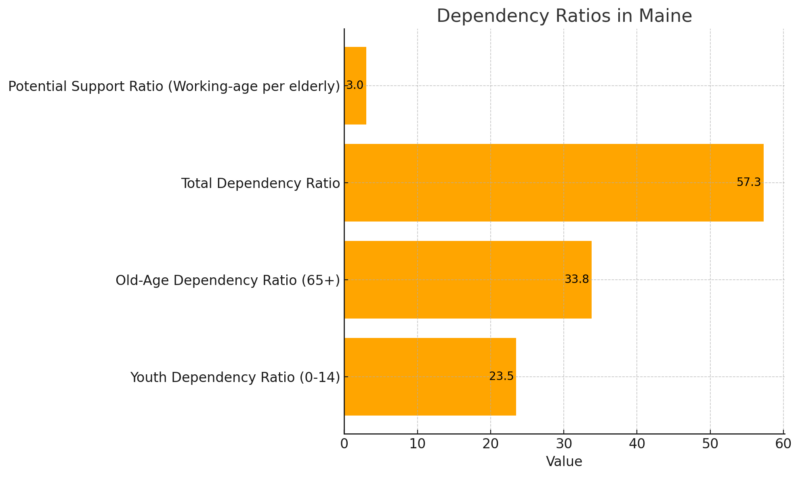
Maine’s population pyramid reflects a demographic trend toward an aging population. The youth dependency ratio of 23.5 indicates that there are relatively fewer children under 14 compared to the working-age population, suggesting declining birth rates.
In contrast, the old-age dependency ratio of 33.8 highlights a significant number of elderly individuals (65 and older) per 100 working-age residents, placing increased pressure on the labor force and social services.
The total dependency ratio of 57.3 reveals that for every 100 working-age individuals, there are approximately 57 dependents (children and elderly combined).
Notably, the potential support ratio of 3.0 means there are just three working-age individuals for every elderly person, underscoring the challenges of an aging population in Maine, such as labor shortages and greater demand for healthcare and support services.
Ethnic Composition
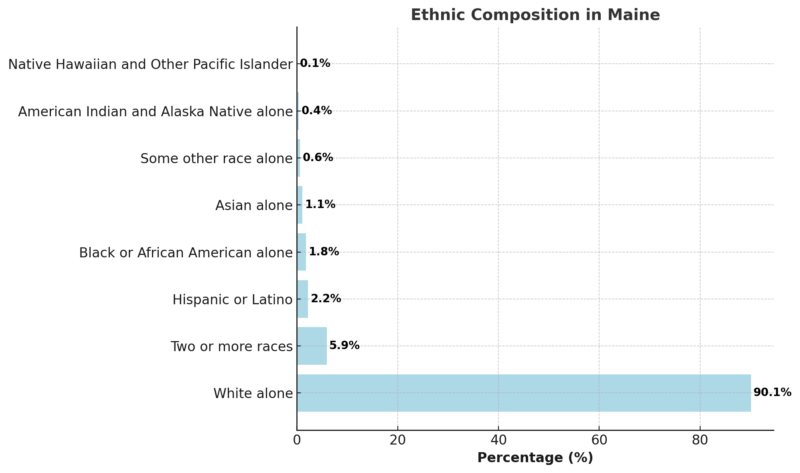
The population of Maine is overwhelmingly White alone, comprising 90.1% of the total residents. This highlights the state’s lack of racial diversity compared to national averages.
The next largest group, individuals identifying as Two or more races, accounts for 5.9%, followed by Hispanic or Latino at 2.2% according to Statista.
Smaller racial groups, including Black or African American, Asian, and American Indian and Alaska Native, make up minimal portions of the population, each under 2%.
Maine Counties Population 2025
County
Population
Growth Rate (%)
Area (sq mi)
Population Density
Cumberland County
311,623
2.65%
323
373
York County
220,222
3.75%
383
222
Penobscot County
155,896
2.45%
1,300
46
Kennebec County
127,983
2.62%
335
148
Androscoggin County
114,305
2.82%
181
244
Aroostook County
67,380
0.47%
2,600
10
Oxford County
60,352
4.24%
802
29
Hancock County
56,503
1.79%
613
36
Somerset County
51,486
2.01%
1,500
13
Waldo County
40,985
3.35%
282
56
Knox County
40,775
0.30%
141
112
Sagadahoc County
37,654
2.51%
98
148
Lincoln County
36,729
4.16%
176
81
Washington County
31,583
1.59%
989
12
Franklin County
31,061
5.41%
655
18
Piscataquis County
17,569
4.53%
1,500
4
WPR notes that Maine has 16 counties, with Cumberland County being the most populous, home to 293,557 people—about 21.93% of the state’s total population. York County follows with 206,229 residents, while Androscoggin County ranks third with 107,679 people. Since the 2010 Census, Cumberland and York counties have grown by 4.30% and 4.57%, respectively, while Androscoggin County saw a slight decline of 0.03%.
Piscataquis County is the least populous in Maine, with 16,800 residents and the lowest population density of 4.24 persons per square kilometer. Its population has declined by 4.27% since 2010. Franklin County (29,897 residents) and Washington County (31,490 residents) also experienced declines of 2.68% and 4.08%, respectively.
In terms of growth, York County leads with a 4.57% increase since 2010, followed by Cumberland County at 4.30% and Waldo County, which grew by 2.25%.
Economy Stats
Metric
Value
Growth Rate (2019-24)
State Rank
Gross State Product (GSP)
$76.6 billion
2.9%
10th
Population
1,402,110
0.9%
13th
Total Businesses
188,458
1.7%
43rd
Employment
843,908
-0.1%
11th
Unemployment Rate
3.6%
4.6%
26th
Maine’s economy has shown moderate growth, with a GSP increasing at 2.9% over the past five years, placing it 10th nationally as noted by IBISWORLD.
The population grew at an annualized rate of 0.9% (ranked 13th), though employment experienced a slight contraction at -0.1%. Unemployment stood at 3.6%, reflecting a relatively stable labor market.
Maine’s Largest Industries by Revenue (2024)
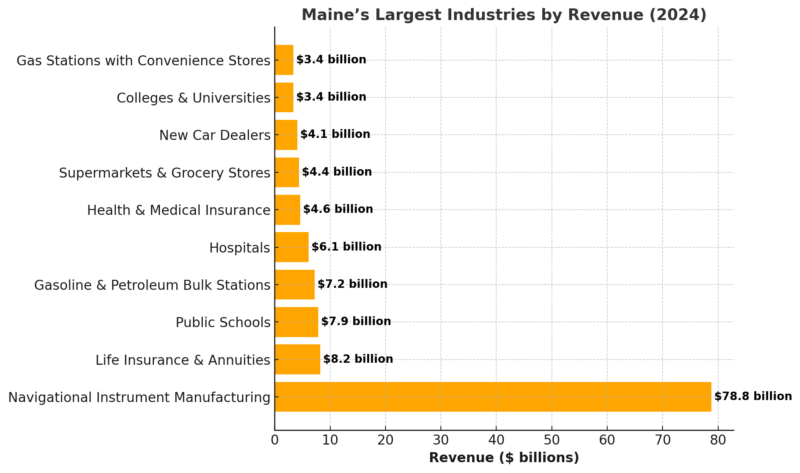
Maine’s economy is heavily reliant on Navigational Instrument Manufacturing, which dominates state revenue at $78.8 billion. Other key industries include Life Insurance & Annuities and Public Schools, demonstrating a mix of manufacturing, healthcare, and service-driven economic activities.
Top Companies Headquartered in Maine by Employment (2024)
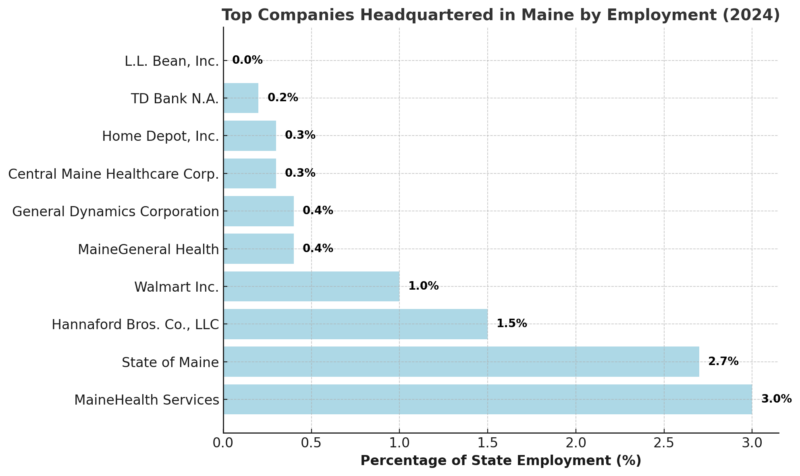
The largest employers in Maine include MaineHealth Services and the State of Maine, which collectively account for 5.7% of statewide employment. Other significant employers include Hannaford Bros. and major national corporations like Walmart and Home Depot.
Maine GDP by Sector (2024)
Sector
GDP ($)
Growth (2024)
Annualized Growth (2019-24)
Real Estate and Rental Leasing
$12.1 billion
2.8%
4.2%
Healthcare and Social Assistance
$8.5 billion
1.5%
1.6%
Retail Trade
$6.7 billion
4.9%
3.0%
Manufacturing
$6.6 billion
-0.6%
1.0%
Professional, Scientific, Technical Services
$5.2 billion
5.4%
6.2%
The largest sectors contributing to Maine’s GDP include Real Estate and Rental Leasing (12.1B), Healthcare (8.5B), and Retail Trade (6.7B). While Manufacturing contracted in 2024 (-0.6%), sectors like Professional and Technical Services showed strong growth.
Maine Employment by Sector (2024)
Sector
Employment
Growth (2024)
Annualized Growth (2019-24)
Manufacturing
250,416
1.8%
-1.5%
Healthcare and Social Assistance
116,887
0.2%
-0.3%
Retail Trade
98,930
-0.2%
0.5%
Professional, Scientific, Technical Services
35,551
2.0%
3.1%
Arts, Entertainment and Recreation
15,096
1.5%
5.6%
The Manufacturing sector employs the largest number of people in Maine, but it has seen an overall decline of -1.5% over the past five years. Growth sectors include Professional Services (2.0%) and Arts and Recreation, which expanded significantly at 5.6% annualized growth.
Immigration Patterns
Metric
Value
Immigrant Share of Population
4.1%
Total Immigrant Residents
57,500
Immigrant Share of Labor Force
4.5%
Immigrant Spending Power
$1.7 billion
Taxes Paid by Immigrants (Total)
$625.1 million
Immigrant Household Income
$2.3 billion
Immigrants make up 4.1% of Maine’s population and contribute significantly to the state’s economy.
American Immigration Council notes that their combined spending power of $1.7 billion and tax contributions of $625.1 million highlight their economic influence as both consumers and taxpayers.
Demographics: Age Distribution
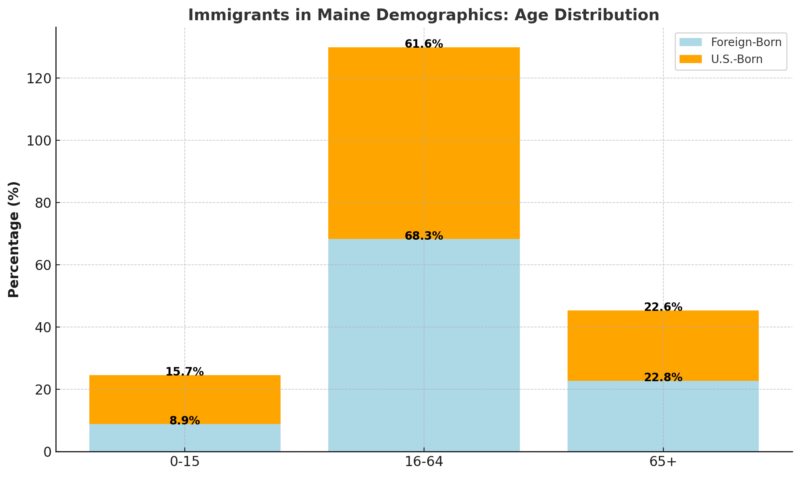
Immigrants in Maine are more likely to be of working age (16-64), with 68.3% falling in this category compared to 61.6% of U.S.-born residents. This age distribution underscores the vital role immigrants play in the labor force, contributing to economic growth and funding programs like Social Security and Medicare.
Immigrant Gender and Language Proficiency
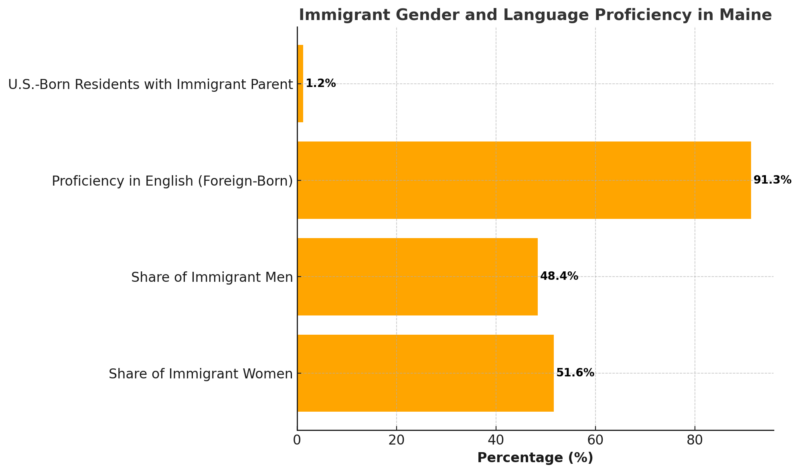
The immigrant population in Maine is nearly evenly split between women (51.6%) and men (48.4%). Additionally, 91.3% of foreign-born residents are proficient in English, highlighting their integration into Maine’s communities. About 1.2% of the population consists of U.S.-born residents with at least one immigrant parent.
Taxes and Contributions to Social Programs
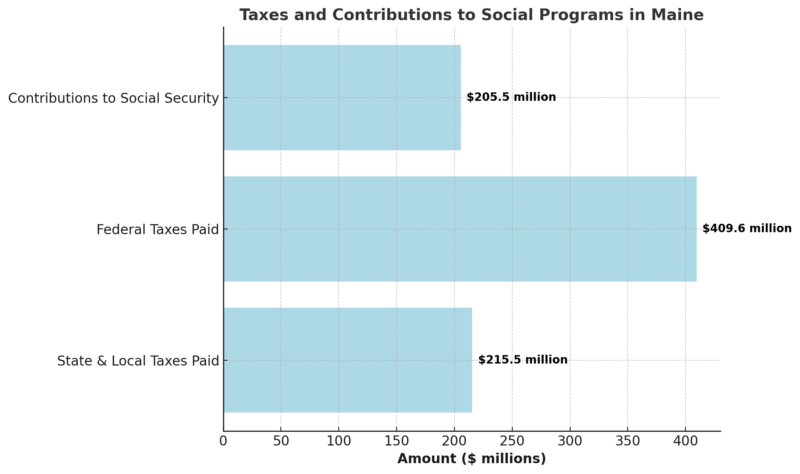
Immigrant households in Maine contribute significantly to public finances, paying over $625.1 million in taxes, including $215.5 million to state and local governments. Additionally, they contribute $205.5 million to Social Security, further supporting critical social programs.
Top Country of Origin
Country
Share of Immigrants (%)
Canada
15.1%
Canada is the leading country of origin for immigrants in Maine, accounting for 15.1% of the foreign-born population. This reflects Maine’s geographic proximity and strong historical ties to Canada.
Health Overview
Health Indicator
Value
Fertility Rate
49.7 births per 1,000 women (15-44)
Teen Birth Rate
8.4 births per 1,000 females (15-19)
Infant Mortality Rate
6.37 per 1,000 live births
Life Expectancy at Birth
76.7 years (2021)
Marriage Rate
7.5 per 1,000
Divorce Rate
2.4 per 1,000
Leading Cause of Death
Heart Disease
Drug Overdose Death Rate
54.3 per 100,000
Firearm Injury Death Rate
11.7 per 100,000
Homicide Rate
2.6 per 100,000
CDC notes that Maine’s fertility rate is relatively low at 49.7 births per 1,000 women of childbearing age, while the teen birth rate is even lower at 8.4 per 1,000, reflecting trends of delayed childbirth and reduced teen pregnancies. However, the infant mortality rate of 6.37 per 1,000 live births remains a concern compared to national averages.
The state’s life expectancy at birth is 76.7 years, which is slightly below the national average, influenced by health challenges such as heart disease, the leading cause of death, and a high drug overdose death rate of 54.3 per 100,000.
Other Birth Data (Maine, 2022)
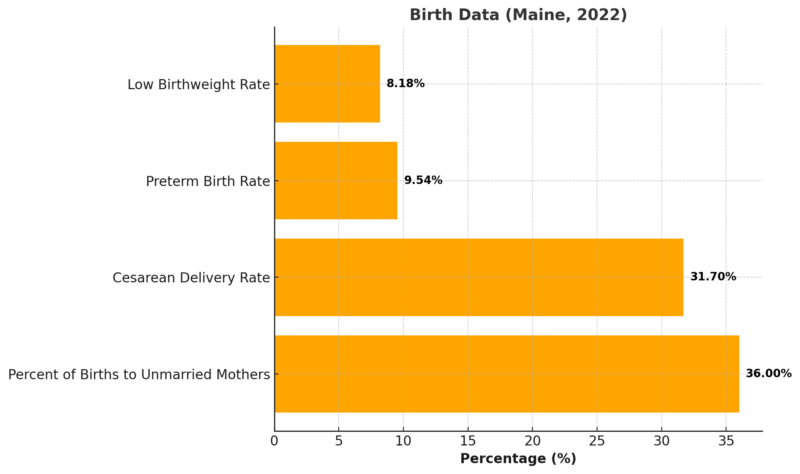
Regarding births, 36% of deliveries were to unmarried mothers, and 31.7% were cesarean deliveries. Additionally, the preterm birth rate of 9.54% and the low birthweight rate of 8.18% highlight areas requiring focused maternal and infant healthcare interventions.
Housing Market
Metric
Value
Growth (YoY)
Median Sale Price
$403,200
+8.3%
Number of Homes Sold
1,493
+2.8%
Median Days on Market
44 days
+14 days
In November 2024, the median sale price of homes in Maine rose to $403,200, marking an 8.3% increase year-over-year according to Redfin.
This growth signals continued appreciation in home values despite economic uncertainties. The number of homes sold also increased by 2.8%, reflecting sustained buyer demand.
However, homes stayed on the market for longer, with the median days on market increasing to 44 days (+14 days), suggesting a slight cooling in the market pace.
Fastest Growing Home Prices by Metro Area
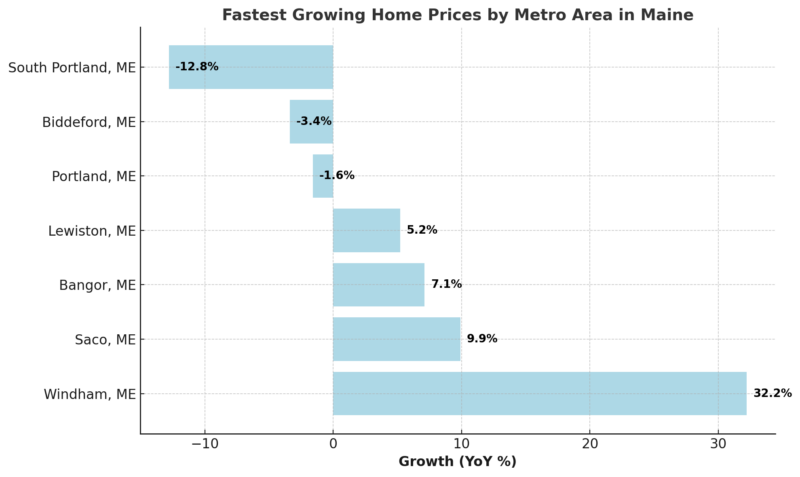
The fastest-growing metro area in Maine is Windham, with an impressive 32.2% increase in sales prices year-over-year. Other areas, such as Saco (+9.9%) and Bangor (+7.1%), also experienced solid price growth.
In contrast, some markets, including Portland (-1.6%), Biddeford (-3.4%), and South Portland (-12.8%), saw price declines, indicating localized market corrections or weaker demand in those areas.
Housing Supply Trends
Metric
Value
Growth (YoY)
Number of Homes for Sale
6,433
+35.3%
Number of Newly Listed Homes
1,370
+10.8%
Months of Supply
3
0%
Maine’s housing supply expanded significantly in November 2024, with 6,433 homes for sale, reflecting a 35.3% increase year-over-year.
Additionally, 1,370 new listings entered the market, up 10.8%, indicating that more sellers are entering the market to capitalize on rising home prices.
Despite this, the months of supply remained steady at 3 months, suggesting a market still leaning towards sellers but showing gradual improvement in inventory levels.
Methodology
This article was crafted using verified data from reputable sources, including the U.S. Census Bureau, IBISWorld, Statista, and the CDC.
Population, economic, housing, and demographic statistics were cross-referenced for accuracy and timeliness.
Key metrics such as population trends, economic indicators, dependency ratios, and health outcomes were summarized concisely.
Housing market insights were derived from Redfin data, ensuring up-to-date market performance.
The analysis highlights Maine’s economic, social, and demographic challenges while showcasing areas of growth.
Each section includes tables and brief insights for clarity and accessibility.
References
- Maine Population by Age – Neilsberg
- Maine Population by Race – Statista
- Maine Counties Population Data – World Population Review
- Maine Economic Stats – IBISWorld
- Maine Housing Market Insights – Redfin
- Maine Immigration Patterns – American Immigration Council
- Maine Health Overview – CDC
Related Posts:
- Tennessee’s Population Growth in 2025 - Key Insights…
- Kansas Population Growth in 2025 - Key Insights
- Connecticut Population in 2025 - Key Demographic…
- Denver Population 2025 - Key Demographic Trends and Insights
- Baltimore Population 2025 - Key Demographic Trends…
- Virginia Beach Population 2025 - Key Trends and Insights








